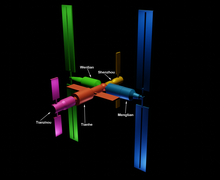Tianzhou 1
Tianzhou 1 (Chinese: 天舟一号) was the debut mission of the Tianzhou-class unmanned cargo spacecraft. It was developed as part of the manned space program of China. Tianzhou means "heavenly vessel" in Chinese.[1] On 20 April 2017, Tianzhou 1 was launched by rocket Long March 7 at China Wenchang Spacecraft Launch Site. It successfully docked with the Tiangong-2 space laboratory on 22 April 2017 at 12:16 (UTC+8).[2] Tianzhou 1 was deorbited on 22 September 2017. It plunged into Earth's atmosphere and burned up after a set of braking maneuvers under ground control.[3]
 A 1:144 scale Tianzhou-1 model | |
| Mission type | Tiangong-2 resupply |
|---|---|
| Operator | CNSA |
| COSPAR ID | 2017-021A |
| SATCAT no. | 42684 |
| Spacecraft properties | |
| Spacecraft | Tianzhou-1 |
| Spacecraft type | Tianzhou |
| Launch mass | Under 13,000 kg (29,000 lb) |
| Dimensions | 9 m × 3.35 m (29.5 ft × 11.0 ft) |
| Start of mission | |
| Launch date | 20 April 2017, 19:41 (UTC+8) |
| Rocket | Long March 7 |
| Launch site | Wenchang LC-2 |
| End of mission | |
| Disposal | deorbited |
| Destroyed | 22 September 2017 |
| Docking with Tiangong-2 | |
| Docking port | Fore |
| Wikimedia Commons has media related to Tianzhou-1. |
Spacecraft
It used the first flight model of the Tianzhou. It is a Chinese automated cargo spacecraft developed from the Tiangong-1 to resupply its future modular space station.
Launch
Tianzhou 1 launched successfully on 20 April 2017 at 7:41pm local time, from the Wenchang space center. This marked the second time a Long March 7 has been used, and the first one for a mission. Tianzhou-1 became the heaviest Chinese spacecraft ever launched, at that time.[4]
Mission
This mission demonstrated the Tianzhou spacecraft and its capabilities. It critically demonstrated propellant transfer for the Chinese space station, the last big hurdle for the long duration expeditions.[5] On April 22, 2017, Tianzhou 1 successfully docked with Tiangong 2 marking the first successful docking of a cargo vessel, and refuelling, with the orbiting space laboratory.[6] It subsequently performed a second docking and refueling on June 15, 2017. After it coupled with Tiangong 2 for a period of 60 days, it decoupled and separated from the space laboratory and completed a three-month period of free flight at around 390 kilometres above the Earth, separately carrying out a range of science experiments. On September 12, 2017, Tianzhou 1 performed the third and final docking and refuel with Tiangong 2, with what is termed a fast docking which took 6.5 hours to complete.[7] Previously the rendezvous and docking process took around two days, or 30 orbits.[8]
References
- "China's space station to be established around 2022". news.xinhuanet.com. September 10, 2014. Archived from the original on January 17, 2015. Retrieved September 11, 2014.
- Barbosa, Rui C. (25 June 2016). "China successfully debuts Long March 7 rocket". NASASpaceflight.com.
- Leonard David (25 September 2017). "FChinese Cargo Spacecraft Burns Up in Earth's Atmosphere". Space.com.
- Stephen Clark (20 April 2017). "First supply ship for Chinese space station lifts off on test flight". Spaceflight Now.
- Ping, Wu (June 2016). "China Manned Space Programme: Its Achievements and Future Developments" (PDF). China Manned Space Agency. Retrieved 2016-06-28.
- "Tiangong-2: China's first cargo spacecraft docks with orbiting space lab". Guardian. 22 April 2017. Retrieved 15 September 2017.
- Clark, Stephen (17 September 2017). "Chinese space station freighter concludes refueling demo mission". Spaceflight Now. Retrieved 5 May 2018.
- "China's Tianzhou-1 cargo craft and Tiangong-2 space lab perform final orbital docking". GBTimes. 12 September 2017. Retrieved 15 September 2017.
